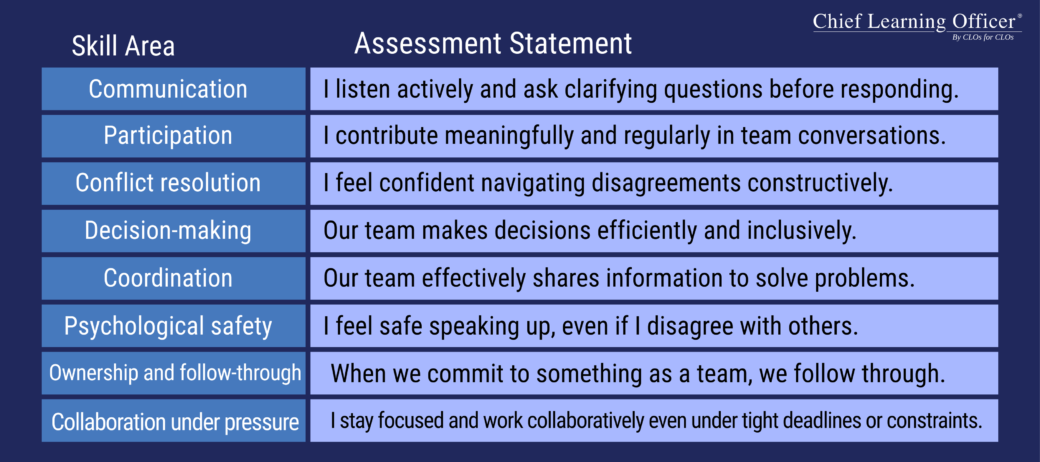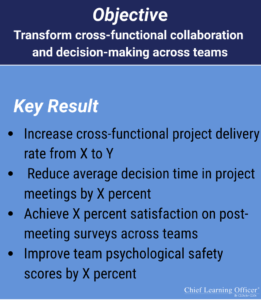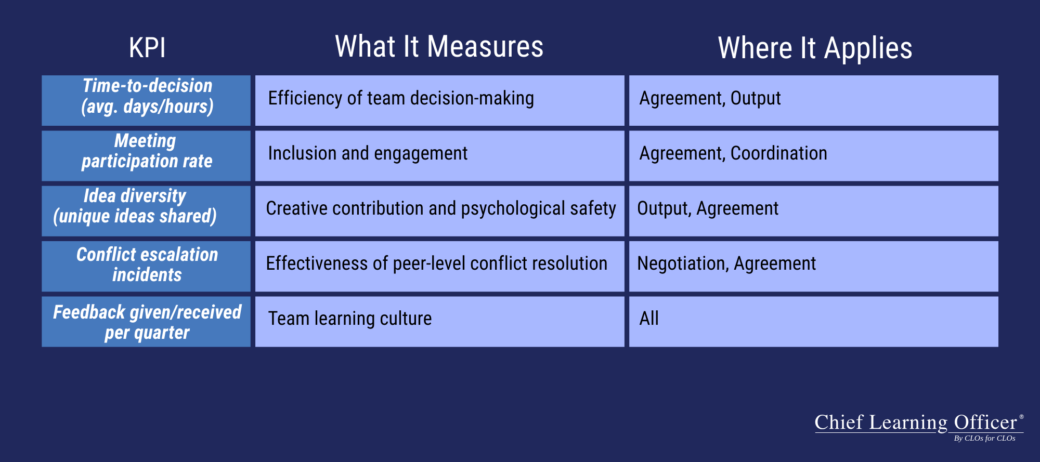High-performing teams are measured in myriad ways, but two characteristics that are crucial to a team’s performance are collaborative problem-solving and the desire for individual team members to help one another succeed.
Suppose you’re building a new team, adding new members to your team or simply trying to improve the performance of an existing team. In that case, collaborative exercises can accelerate performance improvements at critical phases of the team lifecycle, particularly norming, which is characterized by the team learning norms and rituals, conflict resolution, acceptance and recognition, dialogue and cohesion and effective measurements of progress.
As learning and development leaders, you can create fun, engaging and challenging exercises for teams that develop these important characteristics and improve numerous markers of team efficacy. Exercises to improve team performance should be focused on four themes: negotiation, agreement, coordination and output. In this article, I’ll discuss each type of exercise briefly, then how I use a framework to create challenging and engaging exercises to improve collaborative problem-solving and performance on my teams.
Negotiation exercises
“We want different things. Let’s find a way to create value together.”
Teams engage in negotiation more often than people realize. Whenever we prioritize, delegate or assign roles on a project, strategize through conflicting opinions, develop team norms or rituals, or give or receive feedback, we’re negotiating—sometimes in overt ways, and sometimes in very subtle ways.
Negotiation exercises strengthen several important team skills and behaviors: strategic persuasion, reading verbal and nonverbal cues (especially in person), trade-off thinking, making and responding to offers, balancing clear and effective communication skills, developing empathy and creativity, managing conflict and influence dynamics and improving decision-making under pressure and uncertainty. Creating effective negotiation exercises for your team entails creating different goals for different team members and a goal for the whole team. The team must negotiate among themselves to achieve an outcome that satisfies both the individual’s goals and the group’s goals.
Agreement exercises
“We must listen to each other and decide together.”
Similar to negotiation exercises, agreement exercises have a different emphasis. Agreements are less about bargaining between interests and more about reaching consensus through careful, respectful group reasoning. A successful agreement exercise is grounded in group decision-making tasks and involves every teammate contributing to the conversation, with the team coming to consensus on a decision after carefully and efficiently considering everyone’s views, opinions and arguments.
Agreement exercises encourage equal participation, teach people to listen without interrupting or steamrolling and build a team culture of mutual respect when opinions differ. Critical thinking and perspective-taking are improved as team members develop the ability to articulate their point of view clearly, consider alternative perspectives and integrate new information to adjust their opinions.
Coordination exercises
“We each hold part of the answer, and we can only succeed if we work together.”
Coordination is part and parcel of being on a team, and intentionally developing coordination skills has tremendous benefits: clear, intentional communication, the ability to coordinate under pressure or ambiguity, the skill to check for understanding, not just agreement, improving systems thinking and developing trust and accountability.
In coordination exercises, each member of the team is given different information or sets of skills and abilities, and they must pool one another’s information/skills together to solve a problem.
Coordination games are sometimes called “jigsaw” games because each member holds a different piece of the puzzle; no single member can achieve the solution to the exercise on their own and non-participation by any team member can jeopardize completion.
Output exercises
“We can combine our unique skills and perspectives to generate output together.”
Output exercises are among the most powerful team development tools because they simulate real-world collaboration with a tangible outcome. When you need to co-create a result, you can’t fake collaboration.
Output exercises reveal strengths and weaknesses in how teams work together when modeling real-life work that requires combining analysis, decision-making, planning, execution and time management. Because there’s a visible result at the end of an output exercise, whether it’s a slide, plan, pitch or prototype, teams can reflect on both the process and the product, see how decisions affect outcomes and easily spot where they got stuck or soared.
The FRAMED framework
The FRAMED framework is what I use to guide the development of these exercises. It stands for Formation, Roles, Alignment, Mapping, Execution and Debrief.
Formation — What is the real-world challenge you want to simulate?
- Negotiation: Choose a scenario with conflicting stakeholder interests like resource allocation, pricing or role-based priorities, where each person has something to gain or lose.
- Agreement: Frame a situation with an ambiguous or morally complex decision, like who gets limited resources or how to set a policy and require a team discussion and consensus.
- Coordination: Design a task that mimics interdependent work, like a cross-functional project or an emergency response, where nobody can succeed without others’ knowledge or skills.
- Output: Simulate a project-based scenario where the team must produce a deliverable like a plan, pitch or prototype, under time and constraint pressures.
Roles — What perspectives, expertise or blind spots should each participant bring?
- Negotiation: Assign each person a role with a clear personal goal, some leverage and private constraints. Role conflict drives creative deal-making.
- Agreement: Create roles with varied values, identities or stakes in the outcome. Roles shouldn’t be adversarial but should represent diverse views that need reconciling.
- Coordination: Give each participant a unique piece of information, skill or tool. Emphasize that no one can succeed alone. Everyone’s knowledge is essential to the whole.
- Output: Assign functional or character roles with different strengths or limitations. Each role influences the final product, driving creative synergy or potential bottlenecks.
Alignment — What shared goal must the team reach together?
- Negotiation: Define success as reaching a fair, sustainable agreement. The goal is not “winning.” Clarify the group-level consequences of an impasse.
- Agreement: The team must reach full consensus on a decision. The process must be inclusive, respectful and result in everyone agreeing and explaining why.
- Coordination: The team must solve a single correct or optimal answer together. Winning means pooling information and using everyone’s input.
- Output: The team must produce a finished deliverable that satisfies quality, creativity and inclusion of perspectives and present or defend it as a team.
Mapping — What is the story, setting and logic of the scenario?
- Negotiation: Map the players, what each party wants and what’s at stake. Include a brief backstory or stakeholder tensions to ground the roles.
- Agreement: Set a situation with enough complexity and ambiguity to spark disagreement and let the team reason their way to shared understanding.
- Coordination: Define a shared mission and ensure that information and skills are spread across the team like puzzle pieces.
- Output: Create a goal-oriented scenario with prompts that drive both strategic and creative decisions.
Execution — What constraints make the game real and urgent?
- Negotiation: Use a time limit, competing interests or staged rounds to drive momentum and simulate pressure.
- Agreement: Require consensus (no voting or majority rules), set a decision, or introduce a twist partway through to test and challenge the team’s reasoning.
- Coordination: Limit communication channels, apply time pressure or introduce risk if someone doesn’t clearly share their information.
- Output: Apply time limits, presentation rules or resource constrictions. You can even bring in feedback from a mock stakeholder or facilitator.
Debrief — What did the team learn about themselves and each other?
The debrief is one of the most important parts of the framework and shouldn’t be skipped. General and specific questions and deep conversations should be facilitated.
- How did power, bias and compromise shape the outcome? Who created value, and who gave up too soon?
- Did everyone share what they knew? What broke down or worked well in communication?
- Were all voices heard? Was the decision better because of disagreement, or despite it?
- How did the team balance ideas and constraints? What helped or hurt the creative process and what would you do the same or differently next time?
Measuring progress
Pre- and post-assessments
Pre- and post-assessments enable you to see behavioral and perceptual change over time and support self-awareness and developmental ownership. Self-assessments (Likert scale or narrative), 360-style assessments of managers or peers, rubrics for the exercise facilitator and anonymous team surveys are all useful.
Run a baseline assessment with the team prior to the exercises and a post-assessment immediately after, then again six to eight weeks later to track retention and real-world application. Include open-ended questions to get quotes and long-form feedback from participants. A sample 1 – 5 scale assessment is below.

Metrics
Aligning team learning with measurable organizational goals not only improves team performance but also proves the efficacy and value of L&D programs.

Here are examples of OKRs and KPIs that can reflect the value of these exercises in your organization.

Linking team skills to hard outcomes
Another measurement you can use is linking skill to outcome. For example:
- Skill: Consensus-building under time pressure (agreement exercise).
- Behavioral change: Faster alignment in project scoping meetings.
- Hard outcome: Reduced project launch delays by two weeks per cycle.
Onward
These negotiation, agreement, coordination and output exercises are much more than engaging experiences. They build essential, transferable skills that directly impact how teams perform in high-stakes, high-collaboration environments. They can improve the way your team communicates, trusts each other, solves problems and makes decisions by simulating real challenges that require interdependence and accountability. When implemented thoughtfully and measured strategically, they drive measurable outcomes and more inclusive team cultures.















